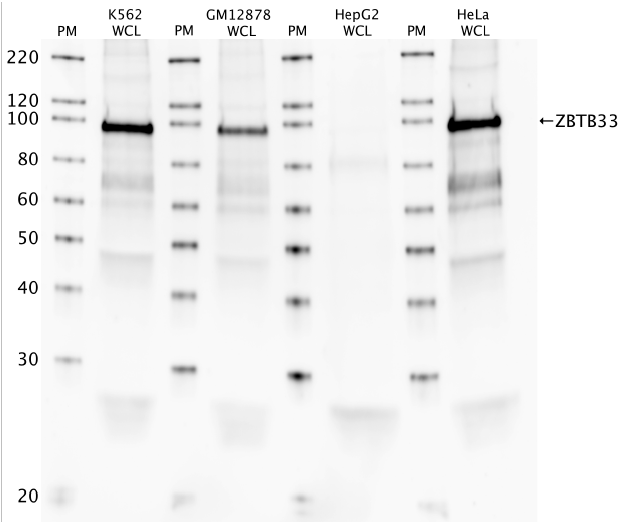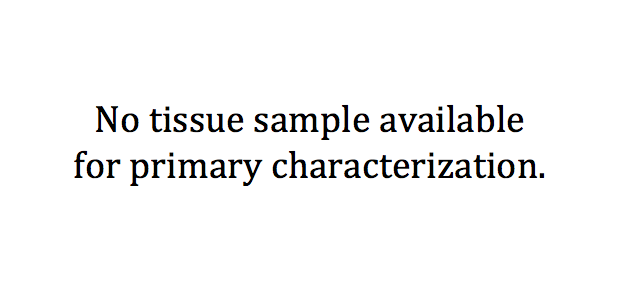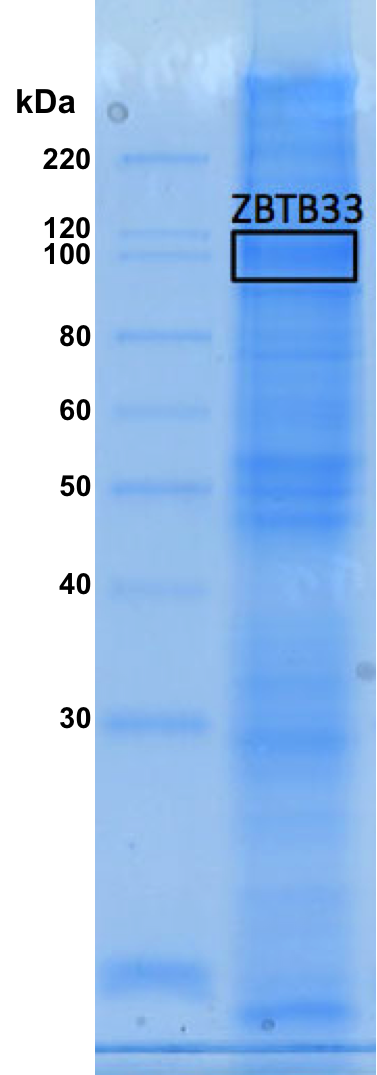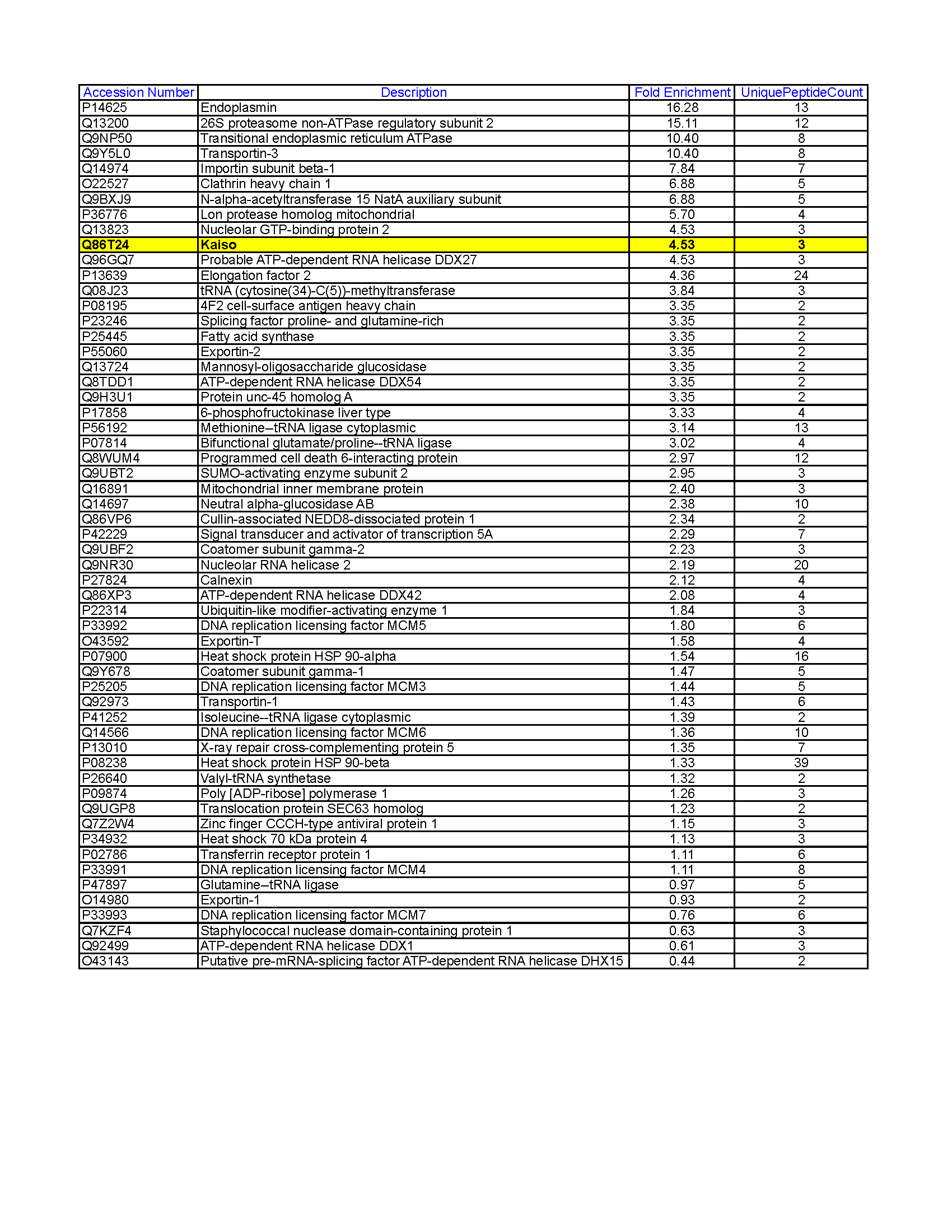ENCAB000AML
Antibody against Homo sapiens ZBTB33
Homo sapiens
K562, GM12878, HeLa-S3, HepG2, liver
characterized to standards with exemption
- Status
- released
- Source (vendor)
- Santa Cruz Biotech
- Product ID
- sc-23871
- Lot ID
- 10308
- Characterized targets
- ZBTB33 (Homo sapiens)
- Host
- mouse
- Clonality
- monoclonal
- Isotype
- IgG1
- Antigen description
- Kaiso (6F8) was Raised against amino acids 1-504 representing full length Kaiso of human origin.
- External resources
Characterizations
ZBTB33 (Homo sapiens)
Method: immunoprecipitation followed by mass spectrometry
not compliant
- Caption
- Briefly, K562 whole cell lysates were immunoprecipitated using sc-98589 (the antibody used to detect ZBTB33 band on the IP-western), and the IP fraction was loaded on a 12% acrylamide gel and separated with a Bio-Rad PROTEAN II xi system. Gel was stained with Coomassie Blue in order to visualize marker bands. A gel fragment corresponding to the band indicated above in the western blot image was excised and sent to the University of Alabama at Birmingham Cancer Center Mass Spectrometry/Proteomics Shared Facility. There the sample was run on an LTQ XL Linear Ion Trap Mass Spectrometer by LC-ESI-MS/MS. Peptides were identified using MASCOT tandem mass spectra analysis, with probability based matching at p < 0.05. As per ENCODE data standards, all MASCOT results are attached, including common contaminants. Target protein is listed as hit 20 (row 21 in file).
- Reviewer comment
- Not compliany by ENCODE2 or 3 standards, and data is not presented clearly.
- Submitted by
- Richard Myers
- Lab
- Richard Myers, HAIB
- Grant
- U54HG004576
ZBTB33 (Homo sapiens)
K562GM12878HeLa-S3HepG2
exempt from standards
- Caption
- Western blot protocol: Whole cell lysate was immunoprecipitated using primary antibody (sc-23871), and the IP fraction was loaded on a 12% acrylamide gel and separated with a Bio-Rad PROTEAN II xi system. After separation, the samples were transferred to a nitrocellulose membrane with an Invitrogen iBlot system. Blotting was performed with sc-98589 Kaiso (H-154) antibody, followed by secondary HRP-conjugated antibody, on an Invitrogen BenchPro 4100 system. Visualization was achieved using SuperSignal West Femto solution (Thermo Scientific). Results: Band of expected size visualized, representing strongest signal in the lane. Figure legend: IP-western with sc-23871 (IP) and sc-98589 (detection) in whole cell lysates (WCL) of K562, GM12878, HepG2, and HeLa; PM=protein marker. ZBTB33 band is indicated.
- Submitter comment
- The lab is asking for an exemption for this characterization because it was done before the agreements to have an IgG control
- Reviewer comment
- As per Antibody review panal decsion of Feb 29, 2016, this will be exempted from standards
- Submitted by
- Richard Myers
- Lab
- Richard Myers, HAIB
- Grant
- U54HG004576
ZBTB33 (Homo sapiens)
liver
exempt from standards
- Caption
- The ENCODE Binding Working Group finds for some valuable tissues that recreating a primary on well characterized antibodies is not cost effective. Therefore, they allow exemption from standards for these tissues.
- Submitter comment
- The lab is asking for an exemption for liver cells due to the lack of resource to make a primary characterization for them
- Reviewer comment
- Exempted by the Feb 29, 2016 antibody review panel
- Submitted by
- Richard Myers
- Lab
- Richard Myers, HAIB
- Grant
- U54HG006998
- Download
- No_tissue.png
ZBTB33 (Homo sapiens)
K562
not submitted for review by lab
- Reviewer comment
- IP gel for mass spectrometry analysis
- Submitted by
- Mark Mackiewicz
- Lab
- Richard Myers, HAIB
- Grant
- U54HG006998
- Download
- ZBTB33_IP-Coomassie_Gel.png
ZBTB33 (Homo sapiens)
compliant
- Caption
- K562 whole cell lysate was immunoprecipitated using the primary antibody (Santa Cruz Biotechnology; sc-23871). The IP fraction was loaded on a 12% Bio-Rad TGX gel and separated with the Bio-Rad Tetra Cell system. A gel fragment (rectangle outline) corresponding to the band indicated on the Coomassie Blue stained gel image was excised and sent to the University of Alabama at Birmingham Cancer Center Mass Spectrometry/Proteomics Shared Facility. Analysis of gel fragment from K562: The sample was analyzed on a LTQ XL Linear Ion Trap Mass Spectrometer by LC-ESI-MS/MS. Peptides were identified using SEQUEST tandem mass spectral analysis with probability based matching at p < 0.05. SEQUEST results were reported with ProteinProphet protXML Viewer (TPP v4.4 JETSTREAM) and filtered for a minimum probability of 0.9. All protein hits that met these criteria were reported, including common contaminants. Fold enrichment for each protein reported was determined using a custom script based on the FC-B score calculation from the reference Mellacheruvu et al., 2013. The CRAPome: a contaminant repository for affinity purification mass spectrometry data. Nat. Methods. 10(8):730-736. Doi:10.1038/nmeth.2557. The target protein, ZBTB33, was identified as the 10th enriched protein and the 1st ranked transcription factor based on IP-Mass Spectrometry.
- Submitted by
- Mark Mackiewicz
- Lab
- Richard Myers, HAIB
- Grant
- U54HG006998
- Download
- ZBTB33_IP-MS.png



